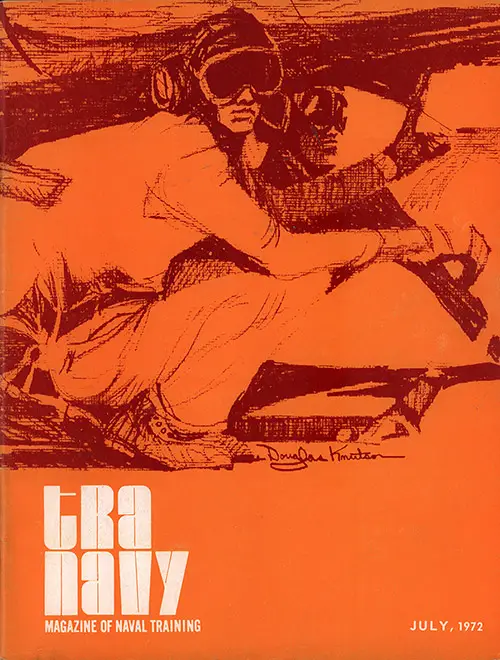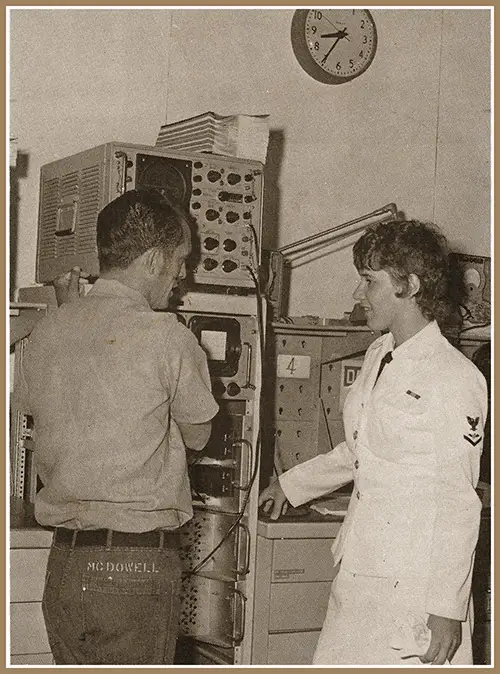TRA NAVY: Naval Training Magazine - July 1972

Front Cover, TRANAVY: Magazine of Naval Training, July 1972. GGA Image ID # 1cfe3251b1
Front Cover By Douglas Knutson, Naval Amphibious School, Coronado, California.
The July 1972 issue featured articles on Recruit Training, Postgraduate School, Saturation Diving, Advanced Undersea Weapons School, First Navy Woman Enters Avionics Course, and More.
Table of Contents
- Director of Naval Education and Training
- Changes in Recruit Training (See Article Below)
- Women Recruit Training Moved
- Postgraduate School
- Saturation Diving
- Instructor Profiles
- Mayport Training Board
- Computer Training
- Drownproofing
- Language Training
- Advanced Undersea Weapons School
- Correspondence Course Center
- Davy Jones Locker
- People Pages
Recruit Training Shortened
Basic Military training for Navy recruits has been shortened from nine to seven weeks with the addition of apprentice training for some forty percent of recruit graduates.
Changes in the recruit curriculum dovetail with the new three-year enlistment programs recently announced by the Navy. Under the two enlistment options, Seafarer and Airman, the recruit is guaranteed duty with one of the Navy's seagoing units without the longer active duty commitment imposed by attendance at an advanced training school.
After the seven weeks of recruit training, most graduates will attend class ''A'' school training in a specialized field. The remainder will form into apprentice companies for training as a seaman (general shipboard duties), fireman (engineering assignments), airman (aviation duties), or construction man (Seabee or construction trade assignments).
The three Navy recruit training commands at Orlando, San Diego, and Great Lakes train seamen and firemen in the 17-day apprentice course. As an interim measure, airman apprentice training is continued at the Naval Air Technical Training Center in Memphis, but this is expected to be moved to the recruit training centers later in the Fall.
For construction men, apprenticeship is four weeks and conducted at Gulfport, Miss.
The Seafarer and Airman enlistment programs are open to 17-year-olds who are high school graduates or 18 to 31-year-olds who hold a high school diploma or an equivalency. Waivers may be granted to non-high school graduates who score high enough on entrance examinations.
-- Page 5, TRA NAVY, July 1972
First Navy Woman Enters Avionics Course

AQ3 Isabella Jennifer Strole, a Pretty 19-Year-old Navy Memphis WAVE Became the Navy's First Woman Aviation Fire Control Technician. TRA NAVY: Magazine of Naval Training, July 1972, p. 43. GGA Image ID # 1cff2ea811
Another male "bastion" crumbled last week when a pretty 19-year-old Navy Memphis WAVE became the Navy's first woman aviation fire control technician.
Isabella Jennifer Strole proudly sewed on her AQ3 crow after completing Avionics "A' School.
On May 21, 1972, she will begin the 26-week Advanced First Term Avionics (AFTA) Class 'B' course, where she will study math and physics, electronics, computers, airborne radar, fire control systems, and avionics maintenance, a world formerly reserved for "men only."
The AQ rating was one of five recently opened to women by the Bureau of Naval Personnel, bringing their total occupational fields to 24. The other four were: lithographers, illustrator draftsmen, musicians (vocalists), and aviation antisubmarine warfare technicians.
The blonde St. Louis native said she chose the AQ rating because she is interested in working with computers and felt she would have a better chance for advancement.
When asked if she expected any unique problems as the only woman among 600 AFTA students, she replied: "No, I don't think there will be any great difficulties, maybe a few minor ones.
I was the only woman in my AV 'A' class and finished fifth in a class of 22. I received the usual good-natured joking but nothing vicious. However, when I learned that I was to become an AQ, some men felt I would take all the AQ shore billets in the Navy. I thought this was unfair and unwarranted."
After completing her schooling in November, she wants to be assigned to an attack squadron. When asked what her status would be when the squadron deployed aboard the ship, she suggested that she might be one of the people typically left behind upon deployment.
Isabella joined the Navy in September 1971 and was sworn in by her father, Lieutenant Commander Douglas Strole, in Naples, Italy, where he is the public affairs officer for the Naval Support Activity. She also spent two years in Formosa when her father was stationed there from 1963-65.
Isabella says she would like to be able to serve on sea duty, preferably aboard a carrier. She is realistic but not pessimistic about the present situation. "I don't foresee women serving on combat ships in the near future, but it may not be too far off. Who would have thought just a few years ago that we would have a lady admiral in 1972?" she added.
-- TRA NAVY: Magazine of Naval Training, July 1972, p,. 43.
TRA NAVY, the magazine of Naval Training. Is published quarterly by the Chief of Naval Training. NAS Pensacola, Fla., 32508, In accordance with the provisions of NAVEXOS P-35 revised. It Is printed commercially with appropriated funds. Official Navy photographs are used, unless otherwise credited. Opinions expressed herein are not necessarily those of the Navy or the Department of Defense.
